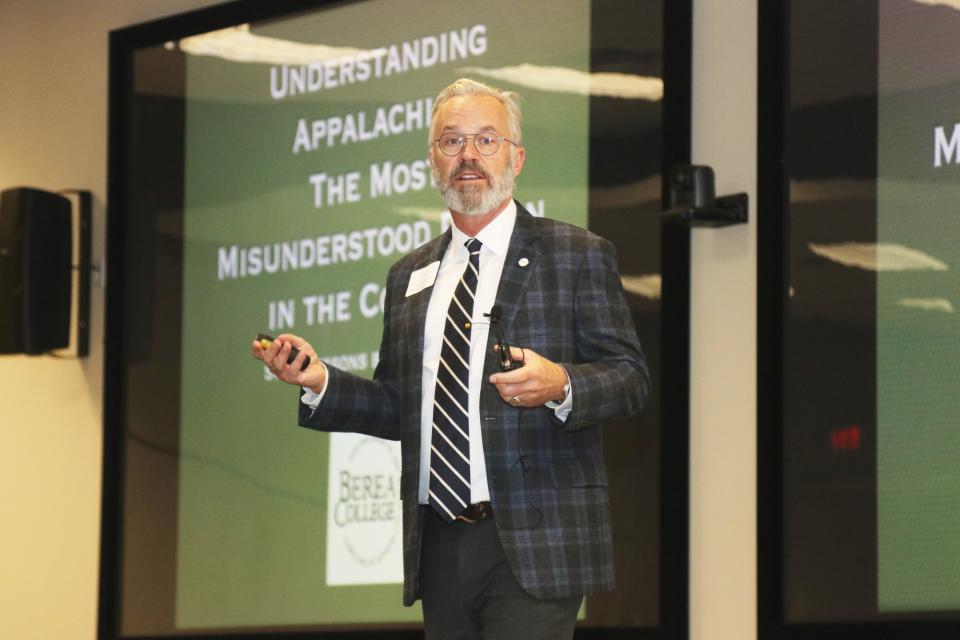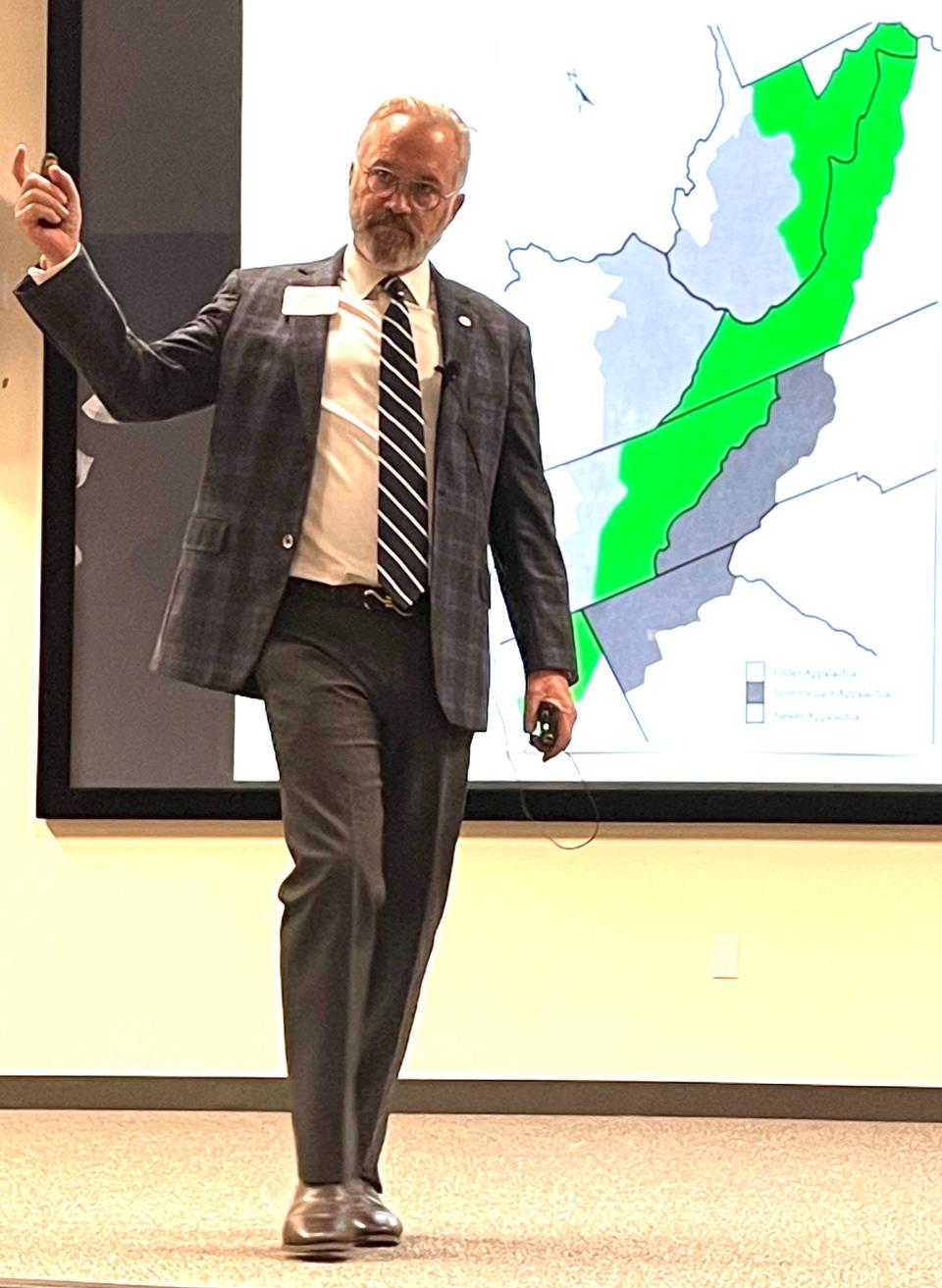Why Appalachia is the most misunderstood region of the US
Americans’ general perceptions of the Appalachian region and its people don't agree with the facts about its diverse population and history, according to a history professor who is considered a leading authority on the topic.
Speaking Feb. 8 in Oak Ridge, Chad Berry suggested that many Americans have been taught to view most residents of Appalachia as “the other,” who are peculiar and different from the people who have achieved more prosperity in industrialized, urban environments.

Gleaning from his experiences traveling to more than 50 countries, Berry said, “Every country I’ve ever been to has this trait where people in a certain region are thought of in the same way as Americans perceive Appalachia and its people. As they’re climbing the economic ladder, they say, ‘Wait, what am I stepping on? Oh, that’s somebody else’s fingers.’”
Berry delivered the first free talk in the American Roots Exploration of Cultures series of four lectures hosted by the Oak Ridge Institute for Continued Learning and the Oak Ridge Breakfast Rotary Club. The remaining three talks will address the persecution of a Muslim minority in China, policies affecting Latino immigration and the Jewish experience in East Tennessee. All three presentations, like Berry's, will be delivered at the Consolidated Nuclear Services (CNS) Y-12 New Hope Center, 602 Scarboro Road.
Berry works as vice president for alumni, communications and philanthropy at Berea College in Kentucky, as well as being a Goode Professor of Appalachian Studies and professor of history. He's widely published in the area of Appalachian studies.
The history
The Appalachian region is home to 26.3 million people who live in parts of Tennessee, Alabama, Georgia, Kentucky, Maryland, Mississippi, New York, North Carolina, Ohio, Pennsylvania, South Carolina, and Virginia, and all of West Virginia, according to Wikipedia.
In his talk, Berry countered American myths about residents of “Appalachia,” a word derived from the 1653 name for an Indigenous population in Central Florida called the Apalachee Indians (Apalachee can mean “people on the other side”).
“Appalachia has always been a tri-racial society consisting of Indigenous, African-American and European Americans,” Berry said.

His talk focused mostly on the white European immigrants because they had rights - unlike the Black and Indigenous residents of Appalachia. The first generation of Europeans that immigrated to the United States arrived in Philadelphia in 1795, he said.
"Physical geography has dictated settlement patterns and histories since the 18th century in Appalachia,” he added, noting that many immigrants moving west in Pennsylvania settled in the mountains or moved south to the Blue Ridge Mountains and Great Smoky Mountains.
“The mountains would be nearly impossible to traverse, so instead, people quickly settled the eastern half of the country and then started going down South and westerly through the valley of Virginia and into the great valley of Tennessee,” he said. “The area around Knoxville became an economic frontier as the population grew.
“There were plenty of natural resources to exploit, like the great fertile soils of the Tennessee Valley and the great trees they would fell for lumber. Women would have 10 or more children because families needed to create their own labor supply for their farms. There was a high potential for economic opportunity," he said.
Berry added that “until the Civil War in the 1860s, middling economic prosperity across much of Appalachia was relatively widespread among the Europeans.”
There were hardly any poor white households until after the Civil War, he said.
“The Civil War in the eastern theater was largely fought in Appalachia’s backyard. Houses were burned, fences were destroyed, land and livestock were devastated.
“Appalachians faced economic challenges, and there was no economic frontier to which young people, white and black, could migrate to. They had no place to go to earn a living. They had to do coal mining. Appalachia was rapidly industrialized. Economic change can happen very rapidly, but cultural change can take a very long time," he said.
Berry noted that “children were no longer needed for a family’s labor supply. Those children who were growing up became a real liability; each one was viewed as an extra mouth to feed for families living in poverty.”
In 1920, he said, Leslie County, Kentucky had the nation’s highest birth rate and no viable economic frontier. He added that it was not easy then for grown children to leave the area for better jobs.
Another point Berry made was that “Appalachia is a social and cultural construct that influences how we think of the region and its people today. A triracial region became whitewashed to include only those from western and northern Europe.”
How Appalachians are perceived
He presented a list of influences on how most Americans perceive people in Appalachia: Americans living in the northern states who view Southerners as “people in need”; Protestant ministers and missionaries, who wrote about “peculiar” religious practices like snake handling; college presidents; physicians, who wrote articles about Southern people afflicted with parasites; local color novels; photographs, movies, TV programs and the news media.
He noted that the Louisville Courier Journal and New York Times in the 19th century extensively covered the Hatfield-McCoy feud that involved two American families of the West Virginia–Kentucky area from 1863 to 1891. By making “people in a mountainous region seem subhuman,” Berry suggested, the news media coverage would help middle-class workers with better paying jobs in cities feel as if “their lives were an improvement.”
Berry also argued that Americans “have been taught to conceive of the people and the region of Appalachia in a bifurcated way. By showing the audience two different photographs, he made the point that “we’ve been taught to think in a dualistic way about the people in the region.”
In one photo a white man stands on a sled being pulled by mules in a tobacco field with beautiful green hills in the background.
“Look at the scenery behind him,” Berry said. “Do you think of the line in a Dolly Parton song, ‘In the good old days when times were bad’?”
Berry presented two possible scenarios for the photo. He talked about a couple longing to move from a city to the mountains in the Southeast to live a simple life in an authentic Appalachian cabin while raising vegetables and taking up knitting. He spoke of another imaginary couple renting such a cabin and then buying a quilt to display back home as a conversation piece “since we don’t need it on the bed because it’s so antiquated and because we have an electric blanket and central heat.”
Then he showed a Lee Adams photograph taken somewhere in Kentucky in which a family poses by their trailer and several dogs. Some people, he said, call them “trailer trash” and ask, “Why do these people have so many kids and so many dogs?”
Berry asked what the photo might suggest to people in California's Silicon Valley or Austin, Texas. He suggested that many viewing the photo would think of such stereotypes as welfare and food stamps recipients and drug users.
“Appalachia” serves a particular function in the nation, Berry said. “If it hadn’t been constructed, another region would likely have been created to take its place.”
He quoted two authors, starting with Altina Waller, who wrote the following in the 1995 book “Appalachia in the Making”:
“Beginning in the 1870s and 1880s, Americans perceived Appalachia as a strange place inhabited by ‘peculiar’ people. This perception ... came not from ... reality of, but from the needs of middle-class Americans in industrializing America to project their own nostalgia for the past and fears about the future onto a people perceived as different. Appalachia became the ‘other,’ a place and a people to be admired, patronized, converted, taught, uplifted, disciplined and sometimes even emulated.”
Concerning the hillbilly stereotype, J.W. Williamson wrote in 1995, “We want to be him and we want to flee him.”
Think about your assumptions
Berry’s advice to his audiences is to “think even more critically about what you assume you know about Appalachia, unlearning some concepts and learning others. It’s important to unlearn what you think you know.”
“Students at Berea College who’ve grown up in the mountains have been taught not to come back here after college because there’s nothing to come back to,” Berry said of the college where he works. “They’re told to get an education and go do something somewhere else, which is terribly sad.
“They’ve been taught to be ashamed of their history and their heritage. But if they take a class on Appalachian studies, then they become transformed because they discover that it’s a legitimate academic inquiry. They learn to love and celebrate their mountain culture and to see what they ought to change.”
This article originally appeared on Oakridger: Why Appalachia is the most misunderstood region of the US

